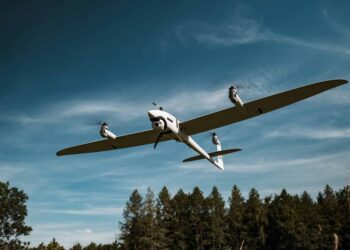EDWARDS AIR FORCE BASE, Calif.: Engineers with the 418th Flight Test Squadron are currently testing a C-130H3 cargo plane equipped with Hamilton Sundstrand NP 2000 propellers.
The new eight-bladed composite propellers are shaped to provide additional thrust in the takeoff and low airspeed range while using the current C-130 engines.
Regular C-130 “legacy” planes use four-blade propellers. With eight blades, the NP 2000 props are designed to perform with more power and efficiency.
“A major limitation propellers have is the wave drag generated by shockwaves when the propeller tips go supersonic,” said Dustin Marschik, a 418th FTS performance and flying qualities engineer. “Newer propeller designs aim to reduce this wave drag, which improves efficiency and performance. The NP 2000 blade design incorporates a more efficient airfoil design, which theoretically will lead to improved performance in the takeoff and climb out phases of flight.
“The eight-bladed props are much more efficiently designed and utilize modern design and manufacturing methods which aim to optimize twist and blade sweep to improve performance,” Mr. Marschik said.
Computer simulation and the composite materials that make up the blades help engineers optimize the blade angle and twists to make the propeller faster and better.
“It is designed specifically for the LC-130 mission in Antarctica,” said Maj. C.B. Cain, a C-130 flight commander. “Right now, they use these jet-assisted takeoff bottles to help them takeoff to get to about a 60-knot takeoff range. If this propeller does what it is supposed to do, then it would produce additional thrust and reduce the need for those JATO bottles, or eliminate them completely.”
Engineers have been conducting performance testing since May on the NP 2000 propeller to characterize how the propeller performs to produce a flight manual for the LC-130, or any other C-130 that may be outfitted with the new prop.
The 418th engineers just wrapped up flight tests involving velocity minimum control airspeed Oct. 28, with Edward AFB’s only C-130H3.
“This is where we shut down an engine on purpose and slow down to find the point where we have neutral directional control,” Major Cain said. “It involves the pilot putting 180-pounds of rudder force in and then slowing, putting it in a five-degree bank angle, and seeing where the directional control switches back the other way.”
“If you lose an engine, this is the slowest you ever want to get. Any slower and you wouldn’t have positive control of the heading of the aircraft.”
In the previous week, squadron testers completed takeoff tests to see how the cargo plane and its propellers perform on maximum-power takeoffs as well as landing tests, which included free-roll landings to see how the plane stops without using its brakes and using reverse thrust.
Major Cain said test data still needs to be analyzed, but preliminary testing has shown that the eight-bladed NP 2000 propeller provides noticeable drag on the free-roll landing tests and the C-130H3 seems to fly smoother.
He said with less vibration, there is less wear and tear on the propeller, which can also be an added benefit.
“Instead of four similar airfoil blades pounding around up there, you have these eight highly tuned blades that make it smoother with less vibration,” Major Cain said. “From a maintainability standpoint, you can change one blade at a time. On the legacy four-blade C-130, you have to change out the whole prop.”
This flight testing is a continuation of a process to improve the capability of the Air Force’s workhorse C-130 fleet. The C-130J “Super” Hercules already employs a six-bladed composite propeller.
“The NP 2000 has been optimized more and represents the next step in propeller technology,” said Major Cain.
In the coming months, the NP 2000 propellers will be replaced on the C-130H3 with legacy four-blade propellers to conduct flight tests to directly compare the performance differences between new and old.
Additional testing will involve taking off with a maximum combat-load weight and conducting takeoffs on three engines and malfunction simulations.
Major Cain said flight tests for the NP 2000 C-130H3 will likely go through January 2011.
Once all the data is assessed, and if Air Force officials see a solid benefit of the NP 2000, certain C-130s may get a new and improved upgrade in the future.









